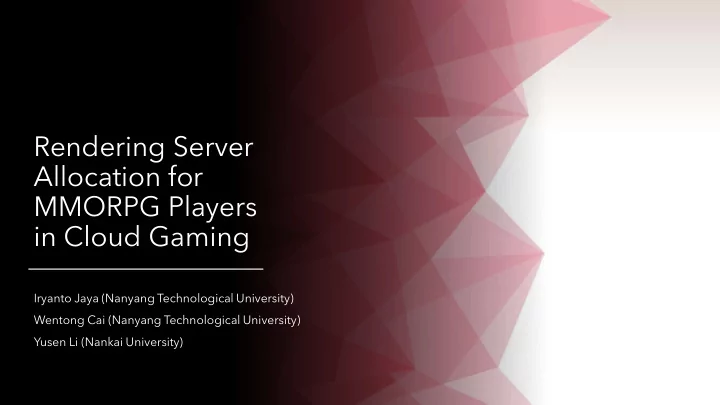

Rendering Server Allocation for MMORPG Players in Cloud Gaming Iryanto Jaya (Nanyang Technological University) Wentong Cai (Nanyang Technological University) Yusen Li (Nankai University)
Background Problem Definition Agenda Proposed Solutions Experiments Conclusions and Future Works 2
Motivations • Multiplayer cloud gaming • Reducing the cost for cloud gaming service providers 3
Problem Allocating players to rendering servers (RSes) Our goal Minimize the cost of using RSes Executive Observation The RS resource capacity is the most limiting factor Summary in the allocation Key idea Use rendering workload sharing to reduce resource usage Results Workload sharing reduces cost of RSes 4
Quality of Cloud Experience gaming (QoE) Related Works Resource Multiview allocation Rendering 5
Resource Allocation RS AND PLAYER NP-HARD MULTIPLE TIME OFFLINE VS. ALLOCATIONS INSTANCES ONLINE PROBLEM 6
Multiview Rendering Left eye Right eye 7
Challenges & Contributions Dependency Multiview Optimization between players rendering in over multiple allocated to one cloud gaming time instances RS 8
Conventional Cloud Gaming Architecture 9
Key Rationale for Architecture Design • Make use of common information from players in the same virtual map • Split the rendering process into two parts: view dependent and view independent • The game server consists of a central game server to maintain non-visual information (database, login information, etc.) while map servers maintain the game scenes 10
Proposed Cloud Gaming Architecture 11
Problem Definition Optimization problem Objective: • Minimize server cost Constraints: • Server capacity • Latency 12
Detailed Problem Formulation Objective 𝑢 Cost 𝑠 Minimize 𝑨 𝑠 𝑢 𝑠 Constraints Subject to: Assignment ∀𝑢, ∀𝑞 ∈ 𝐽 𝑢 , 𝑦 𝑞, 𝑠 = 1 𝑠 ′ ≤ 𝐷 𝑠 𝑢 CPU capacity ∀𝑢, ∀𝑠, 𝑦 𝑞,𝑠 𝑑 Γ 𝑞 + 𝑧 𝑠, 𝑛 𝑑 𝑛 𝑞∈𝐽 𝑢 𝑛 GPU capacity ∀𝑢, ∀𝑠, 𝑦 𝑞,𝑠 Γ 𝑞 ≤ 𝐻 𝑠 𝑞∈𝐽 𝑢 Latency ∀𝑢, ∀𝑞 ∈ 𝐽 𝑢 , 𝑦 𝑞, 𝑠 𝑚 𝑞, 𝑠 + 𝑚 𝑠, Γ 𝑞 ≤ 𝑀 𝑠 13
Trade off between constraints Challenges Resource allocation is NP-hard Cannot derive a simple algorithm from the problem formulation 14
Obtain the list of eligible RSes from currently active RSes, if there is none, obtain the list from inactive-RSes • Lowest price (LP) Select the lowest priced RS Online • Lowest waste resource (LWR) Waste resource = Capacity – current workload Heuristics Best fit • Highest workload share (HWS) Prioritize possible workload sharing, then use LP to break ties • Lowest waste price (LWP) Waste price = Waste resource / RS cost 15
Offline Algorithms LOCAL SEARCH (LS) LOWER BOUND (LB) GET AN INITIAL SOLUTION, THEN USE LOCAL AN OPTIMAL SOLUTION DERIVED USING A SEARCH TO OPTIMIZE THE COST MATHEMATICAL SOLVER 16
Local Search Aim: to empty RSes with low utilization Algorithm 1. Gets the first solution 2. Sort the RSes with increasing number of players 3. Move each player from lower index RS to higher index RS if possible 4. Stop when there is no possible move 17
• 500+ PlanetLab player nodes • Amazon EC2 & Microsoft Azure to host MSes and RSes • Poisson distribution player arrival • Exponential distribution playing duration Experiments Assumptions: • The number of servers, maps and players are fixed • The latency between involved nodes never change • Each player will be allocated to an RS (no rejection) 18
Default Experiment Parameters 19
Online Heuristics Performance 20
Online Heuristics Performance 21
Comparison with Traditional Cloud Gaming 22
Offline Algorithms Comparison 23
Conclusions and Future Works Conclusions: • MMORPG cloud gaming architecture with multiview rendering • Rendering workload sharing reduces overall cost • Increasing player arrival frequency widens the gap between the costs from online and offline approaches Future works: • Player rejections • Edge server involvement • Future request predictions 24
Q&A 25
Recommend
More recommend